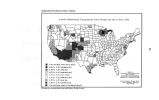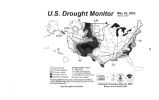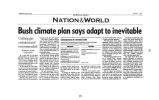| OCR Text |
Show 77 agers to substantially improve the efficiency of water use. Research is now on- going in cooperation with the Utah Water Research Laboratory at USU to develop and implement intelligent computer software that will help the operators of canals and reservoirs in the Sevier River Basin to further increase overall system efficiency through better real- time analysis of data and identification of optimal short- term management decisions. The technology and methods applied in the Sevier River Basin could be exported to other large irrigation systems in Utah and the Utah Water Research Laboratory would be a valuable asset in the State's efforts to address drought- related water management problems. All of these factors- the lack of a strategic commitment to support systematic data collection efforts, our inability to make good long- term forecasts of precipitation and streamflow, and the need to implement data collection and analysis techniques for more intensive large- system management- make it difficult to achieve greater efficiency of water use for private individuals and water purveyors. Available and Emerging Capabilities Even though the above data collection and forecasting gaps hamper our ability to manage scarce water supplies, capabilities are emerging that promise to improve this situation. These include: Remote Sensing: The science of remote sensing is rapidly developing even as government agencies at all levels reduce their support for the more traditional hydrometeorological data collection methods. While the costs of remote sensing technology are still typically out of the range of most large- scale water systems, and though the technology for extracting useful information for many aspects of water management are not yet well developed ( e. g., accurate estimation of the quantity of water in the snowpack from a combination of airborne and satellite imagery is an important area still requiring significant research), the information potential of remotely sensed data is extremely promising. Long- term Forecasting: The last decade has seen significant advances in the use of sophisticated mathematical tools to recognize the underlying structure of complex hydrologic systems and to provide long- term forecasts of the behavior of those systems. For example, in the 1990s researchers at the Utah Water Research Laboratory at USU developed the best model to date for constructing long- term predictions of future levels of the Great Salt Lake by using the mathematics of chaos theory and pattern recognition. Research is continuing in extending the application of these approaches to forecast future precipitation, streamflow, floods, drought, and so forth. Successful development and implementation of these techniques could potentially provide tremendously valuable information for water managers and individual water users, alike. The Utah Water Research Laboratory is available to help in these efforts. Short- term Forecasting: The past decade has also seen development of new tools for constructing very accurate forecasts of the short- term behavior of complex systems, including river flows and reservoir and canal systems. These approaches often rely on various pattern recognition methodologies such as artificial neural networks and support vector machines. One application of these methods developed at the UWRIV USU is now being tested in the Sevier River Basin in southern Utah to help improve the operation of large complex irrigation systems. Actions Needed to Improve Drought Management In spite of recent scientific advances, much remains to be done before the benefits of the emerging technologies can be fully realized by water users. Further, it should be recognized that investments in these efforts will not provide useful information for dealing with the current drought; they may, however, make the management of the next drought much more feasible and much less economically damaging. Among the critical actions needed to improve drought management are: Data Collection: The diversity of Federal, State, and local agencies involved in various aspects of hydrometeorological data collection must improve the coordination of these activities and work to streamline the dissemination of the data. This includes: • improvements in quality assurance/ quality control for data that are assembled and provided to managers and the public, especially meteorological data • efforts to merge or integrate diverse regional data sets ( e. g., integration of traditional groundbased data collection methods with advances in remote sensing) in order to improve the total regional picture of water conditions; advances in the mathematics of data/ sensor fusion, originally developed in the Department of Defense, show promise in this regard |


























































































